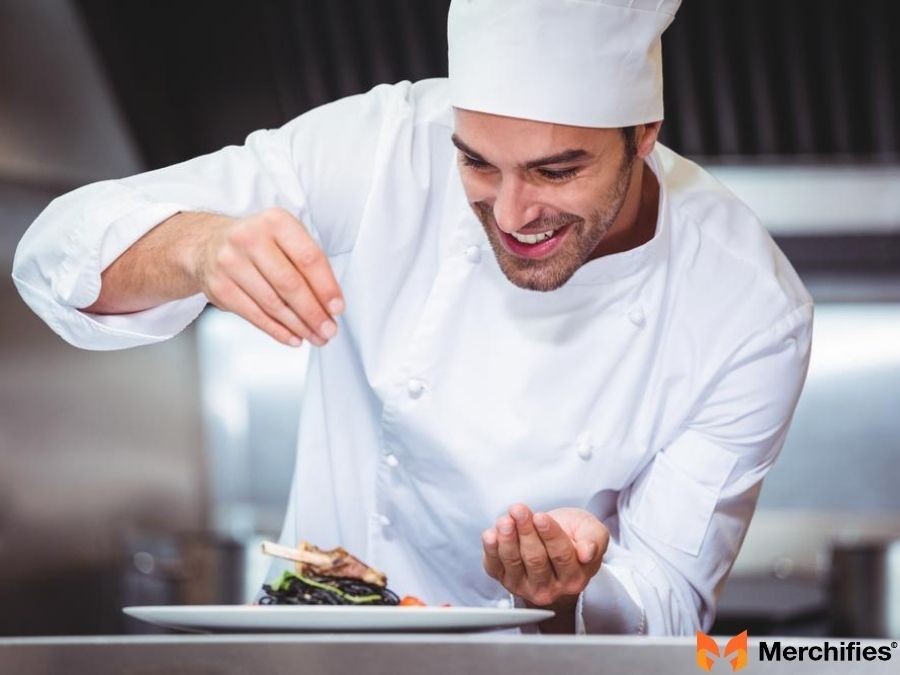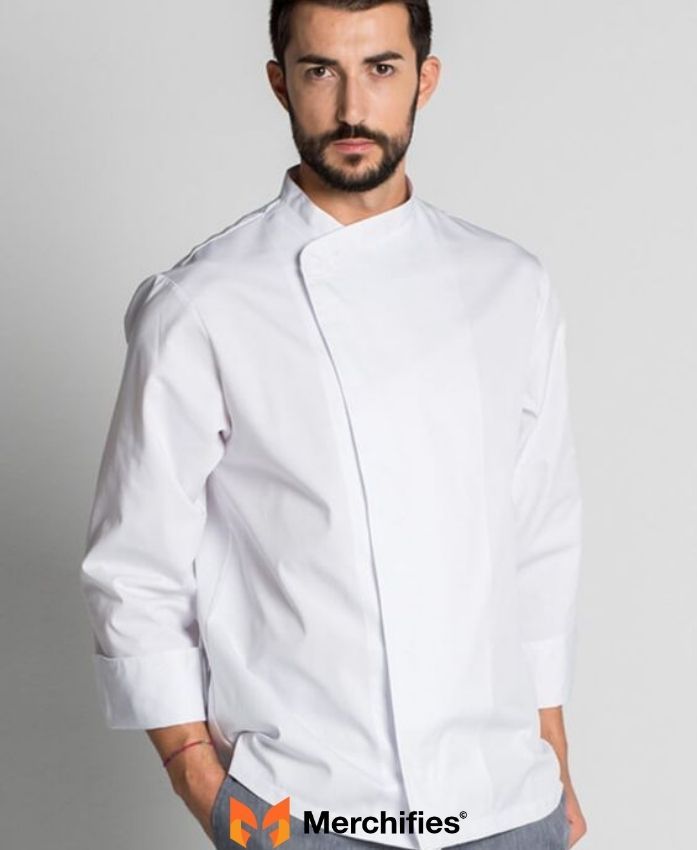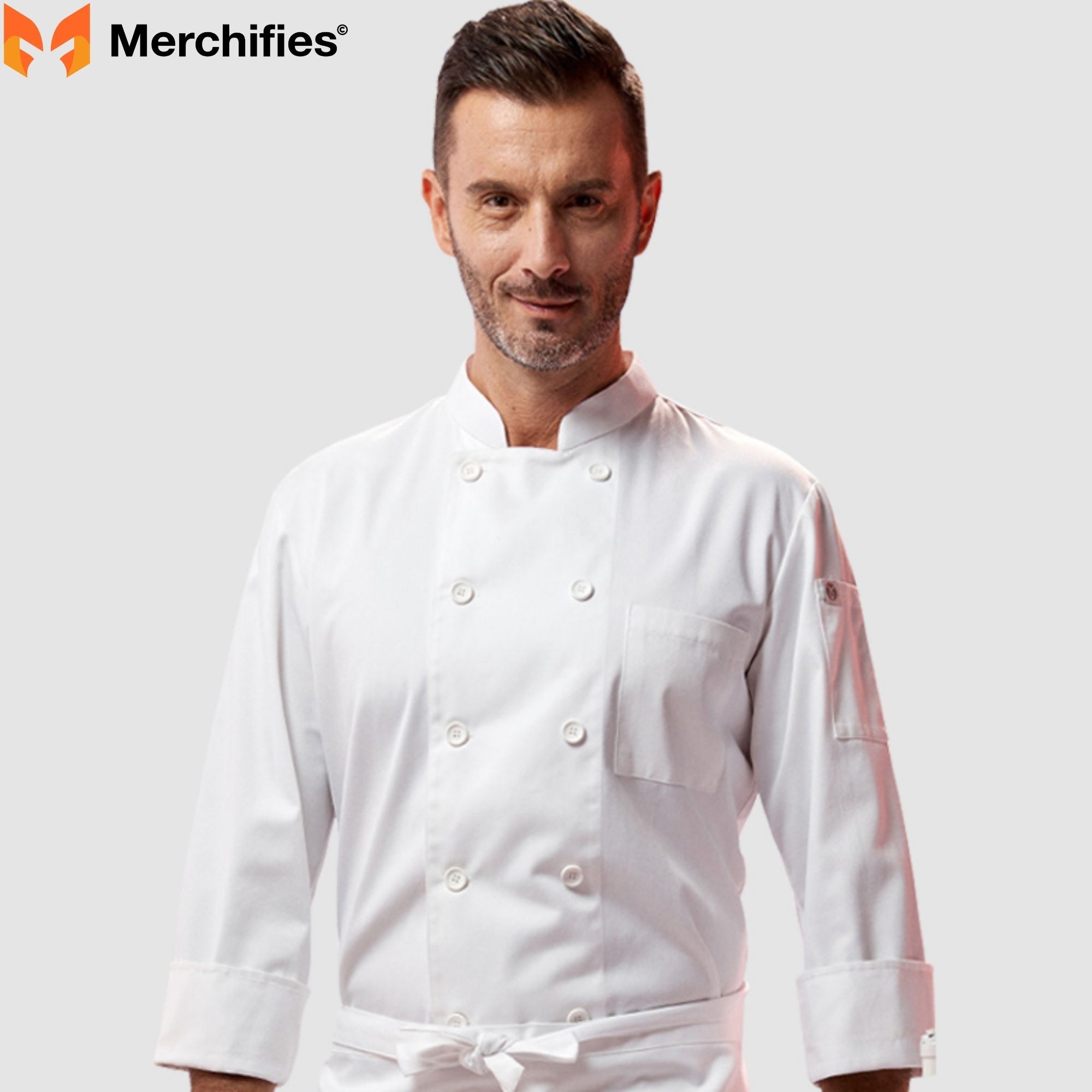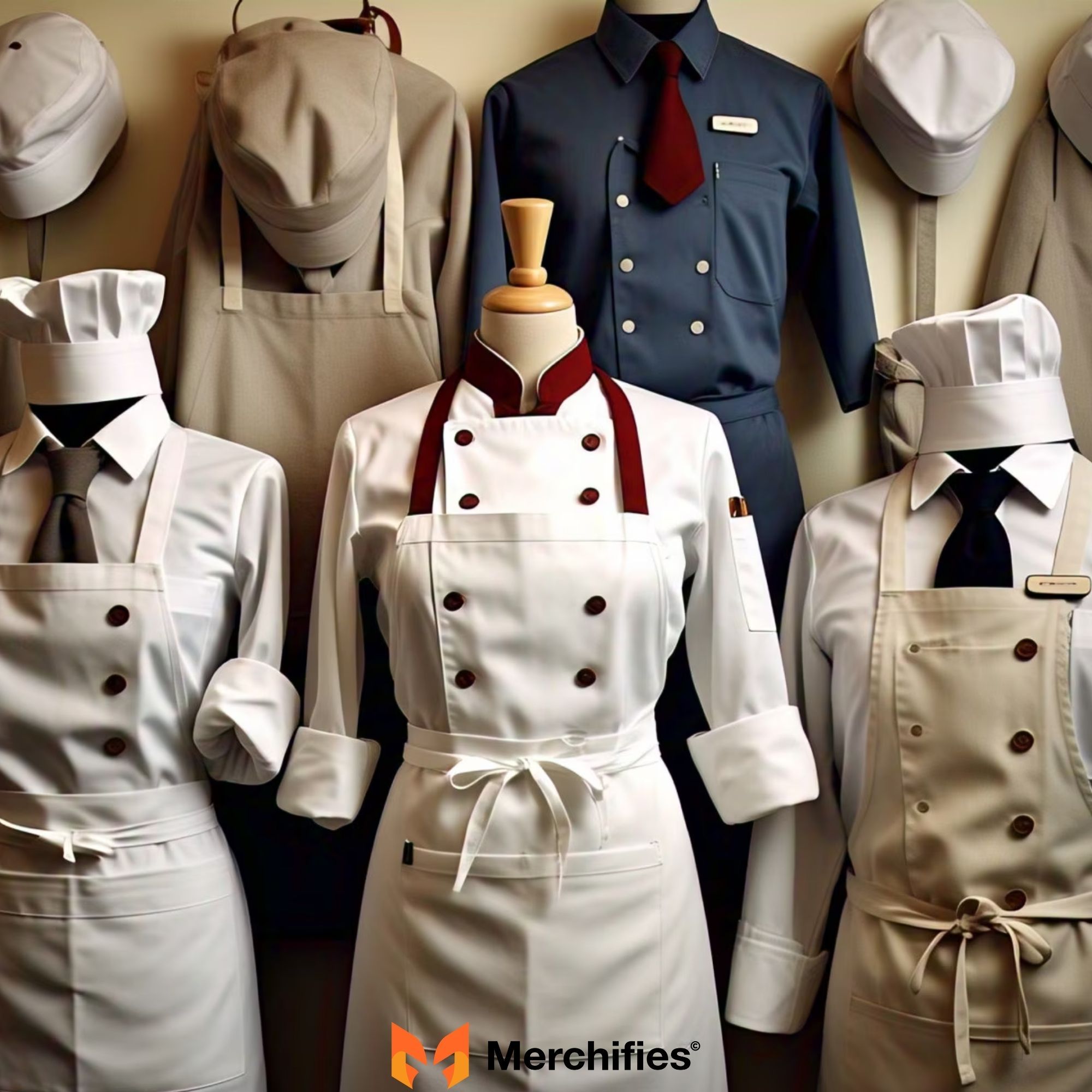Why Every Chef Needs a Signature Shirt
Discover why every chef needs a signature shirt — a blend of style, comfort, and identity that reflects passion, professionalism, and culinary creativity.

Blog Post Contents
From the bustling energy of a Michelin-starred restaurant to the comforting warmth of a local diner, one garment stands as an unspoken symbol of culinary dedication: the chef's uniform. More than just a collection of fabric, this iconic attire carries a rich history, practical purpose, and profound symbolism. It’s an ensemble that instantly communicates professionalism, skill, and an unwavering commitment to the culinary craft.
In this article, we'll dive deep into the fascinating world of the chef's attire, exploring the specific chef work shirt meaning and unveiling the enduring importance of chef uniform as a whole. As an expert in the culinary field, Eli Wilder shares insights into how this uniform has evolved from humble beginnings into the refined professional kitchen wear we recognize today. We will uncover the historical significance, the clever functional design, and the tangible benefits that make the chef's uniform an indispensable part of any professional kitchen.
Decoding the Chef Shirt: History, Symbolism, and Functional Design
The chef shirt, or chef jacket as it's often called, is the cornerstone of the culinary uniform. Its design is not arbitrary; every stitch and seam tells a story of tradition, protection, and professional pride. Understanding the chef shirt meaning begins with appreciating its journey through time and the deliberate thought behind its construction.
A Legacy in Fabric: The Historical Evolution of the Chef Shirt
The origins of the modern chef's uniform can be traced back to the mid-19th century, largely credited to the legendary French chef Marie-Antoine Carême. He advocated for a standardized look for kitchen professionals, emphasizing cleanliness and a sense of order. Before Carême's influence, kitchen attire was haphazard. He championed the "Chef Whites" tradition, believing that white signified hygiene, purity, and the high standards expected in a culinary environment. The choice of white wasn't just aesthetic; it also served a practical purpose by reflecting heat, a crucial advantage in the notoriously hot kitchen environment. This tradition solidified the initial chef shirt meaning as a symbol of meticulousness and dedication to the craft.
The Anatomy of a Classic: Understanding Each Feature of the Chef Shirt
Every detail of the traditional chef shirt, often referred to as a chef jacket, is intentionally designed to serve the chef in a demanding kitchen.
- Double-Breasted Design: This is perhaps the most recognizable feature of a classic chef coat. The double-breasted chef coat offers significant advantages. Primarily, it provides an extra layer of fabric over the chest, enhancing heat protection against hot stoves and unexpected splashes. Its ingenious design also allows for reversibility. Should one side become stained or soiled during a busy service, the chef can simply unbutton and re-button the coat with the cleaner side facing out, maintaining a pristine and professional kitchen wear appearance. This feature underscores the practical chef shirt meaning—a garment built for resilience.
- Knot Buttons (or Studs): The distinctive knot buttons, or chef jacket buttons, are not merely decorative. Made from durable cloth, they are designed to withstand the high temperatures of commercial washing machines and frequent laundering, unlike plastic buttons that could melt or crack. Furthermore, their design allows for quick removal in an emergency, should the coat get caught or become too hot. This traditional element speaks volumes about the uniform's functionality and the traditional chef uniform aesthetic.
- Long Sleeves: A critical safety feature, long sleeves are a non-negotiable part of the chef shirt. They offer vital protection against common kitchen hazards such as burns from hot surfaces or splashes, and cuts from sharp knives. The long sleeve is an essential component of chef safety uniform, shielding the chef's arms from the constant threats inherent in a fast-paced kitchen, making it truly protective kitchen wear.
- High Collar (or Neckerchief): The high collar provides additional protection to the neck area, guarding against steam, splashes, and heat. Historically, chefs also wore a chef neckerchief to absorb sweat, keeping it from dripping into food and maintaining personal hygiene. This element contributes to the comprehensive culinary uniform components focused on both safety and sanitation.
- Pocket Placement (often sleeve pocket): While less common on traditional jackets, modern chef shirts often feature a sleeve pocket. This practical placement allows chefs to keep essential tools like thermometers, pens, or small tasting spoons readily accessible without interfering with their movements or risking contamination from waist-level pockets.
Beyond Function: The Symbolism and Prestige of the Chef Shirt
Beyond its practical applications, the chef shirt carries profound symbolism. It’s universally recognized as a badge of honor and professionalism, signifying entry into a respected and challenging profession. Wearing the chef shirt represents culinary skill, dedication, and a commitment to upholding the standards of the kitchen. It connects the chef to a rich tradition and heritage, a sartorial link to generations of culinary masters.

The Enduring Importance of the Chef Uniform: More Than Just a Look
While the chef shirt forms the core, the complete chef uniform extends its benefits far beyond its individual components. The collective ensemble underscores the importance of chef uniform in ensuring a safe, hygienic, and professional culinary environment.
Practical Imperatives: Safety, Hygiene, and Comfort in the Kitchen
The kitchen is a demanding and often dangerous workspace. The chef uniform addresses these challenges head-on.
- Safety First: The uniform acts as a crucial barrier. Its durable fabric and long sleeves provide protection from hot surfaces, sharp objects, and unexpected spills of boiling liquids or oil. This dedication to chef safety standards ensures that burns and cuts are minimized, allowing chefs to focus on their craft with reduced risk. The uniform is integral to kitchen burn protection.
- Hygiene Standards: In any food preparation environment, hygiene is paramount. The uniform serves as a physical barrier, preventing hair, loose clothing fibers, or skin cells from contaminating food. Its typically light color, especially white, immediately shows dirt or spills, prompting quick changes and reinforcing rigorous food safety uniform protocols. The ease of cleaning and frequent laundering of chef uniforms are central to maintaining kitchen hygiene uniform standards.
- Comfort and Endurance: Chefs spend long hours on their feet in hot, humid environments. Modern chef uniforms, often made from breathable fabrics like cotton or poly-cotton blends, are designed for comfort and endurance. They allow for freedom of movement, crucial for the dynamic tasks involved in cooking, ensuring chefs can perform their duties efficiently without discomfort hindering their performance.
Building an Image: Professionalism and Brand Identity
The uniform plays a pivotal role in shaping perceptions, both inside and outside the kitchen.
- First Impressions: For diners, seeing a uniformed chef or kitchen staff instills confidence in the establishment's standards of cleanliness and professionalism. It suggests attention to detail and a commitment to quality, enhancing the overall dining experience.
- Team Cohesion: A uniform look fosters a sense of unity and shared purpose among the kitchen brigade. It eliminates social distinctions and promotes a cohesive, disciplined team environment, where everyone is working towards a common goal.
- Brand Representation: The chef uniform is an extension of the restaurant's brand. Customized restaurant branding uniform with logos or specific colors can reflect the establishment's unique identity, communicating its quality and standards long before a dish is even tasted. It's a key element of professional culinary attire.
Psychological Impact: Confidence, Authority, and Respect
The act of donning the uniform has a powerful psychological effect.
- For the Chef: Wearing the uniform can boost a chef's self-esteem and focus, helping them mentally transition into their professional role. It instills a sense of pride and responsibility.
- From Colleagues & Patrons: A well-worn uniform commands respect and authority within the kitchen. It clearly delineates roles and responsibilities, promoting a disciplined workflow. For patrons, it reinforces the chef’s expertise and mastery of their domain. As Eli Wilder often emphasizes, "The uniform isn't just what you wear; it's how you wear your commitment to excellence."

Completing the Ensemble: Other Essential Elements of the Chef's Attire
While the chef shirt is central, a complete chef uniform includes several other critical components, each with its own purpose, further solidifying the importance of chef uniform.
The Toque (Chef Hat):
The iconic toque, or chef hat, is far more than a fashion statement. Its primary toque meaning is hygiene, preventing hair from falling into food. The tall, pleated design also aids in heat dissipation from the head. Historically, the number of pleats on a chef hat symbolism could even signify the number of recipes a chef had mastered, adding a layer of traditional prestige.
Chef Pants:
Designed for durability and comfort, chef pants benefits include their loose fit, allowing for ease of movement during long shifts. Often featuring traditional patterns like houndstooth, these patterns are not just for aesthetics; they effectively camouflage minor stains, maintaining a tidy appearance throughout service. They also offer a layer of protection from spills and heat, making them ideal kitchen work pants.
Chef Apron:
The chef apron purpose is to provide an additional layer of protection for the chef's clothing from spills, splatters, and heat. Made from heavy-duty fabric, it can be quickly removed in case of a significant spill or fire hazard. The kitchen apron benefits also include convenient pockets for tools.
Chef Shoes:
Often overlooked but critically important, chef shoes are designed with non-slip chef shoes soles to prevent accidents on potentially wet or greasy kitchen floors. They offer crucial comfort for chefs who spend countless hours on their feet and provide protection from falling objects like knives or heavy pots, making them essential kitchen safety footwear.

Choosing the Right Uniform: Key Considerations for Today's Chefs
The modern culinary world offers innovations in chef uniform design that enhance both performance and comfort.
Fabric Technology & Modern Innovations:
Contemporary chef uniforms often incorporate advanced fabric technologies. Moisture-wicking materials help keep chefs dry by drawing sweat away from the body, while antimicrobial properties help reduce odors and bacterial growth. Stretch fabrics provide greater flexibility and freedom of movement, adapting to the dynamic needs of a busy kitchen.
Fit and Functionality:
A proper fit is crucial. The uniform should be comfortable enough for long hours of strenuous work but professional enough to maintain a sharp appearance. Chefs today look for designs that offer a balance between traditional aesthetics and modern ergonomic functionality.
Durability and Maintenance:
Given the rigorous environment, durability is key. High-quality uniforms are designed to withstand frequent washing and harsh kitchen conditions. Ease of maintenance—such as stain resistance and wrinkle-free properties—also plays a significant role in choice, ensuring the uniform can always look its best.
Personalization & Branding:
Many establishments and individual chefs opt for personalization. Embroidery of names, restaurant logos, or custom designs on chef shirts and aprons further enhances brand identity and instills a sense of individual pride and team belonging.

Frequently Asked Questions (FAQs) About Chef Uniforms
What is the meaning of a chef shirt?
The chef shirt meaning encompasses a rich history of professionalism, hygiene, and protection. It symbolizes the chef's dedication to their craft, their adherence to cleanliness standards (especially through its classic white color), and their practical need for a garment that protects against heat, spills, and cuts in the demanding kitchen environment.
Why is a chef uniform important?
The importance of chef uniform is multi-faceted. It ensures safety by protecting against burns and cuts, promotes hygiene by preventing contamination, and offers comfort for long shifts. Beyond practicality, it projects professionalism, fosters team cohesion, reinforces brand identity, and instills confidence and authority in the wearer.
Why do chef coats have knot buttons?
Chef coats traditionally feature knot buttons because they are durable, heat-resistant, and easy to remove. Unlike plastic buttons, cloth knot buttons can withstand high-temperature washing and won't melt or break. Their design also allows for quick unfastening in emergencies.
What do the different colors of chef uniforms mean?
While white is the most traditional and symbolic color (representing cleanliness and heat reflection), other colors have emerged. Black chef uniforms are popular in front-of-house roles or open kitchens for a modern, sleek look that also hides stains well. Gray or other subdued colors are sometimes used to denote specific roles or simply as a stylistic choice by an establishment.
Is it necessary for chefs to wear a uniform?
Yes, it is highly necessary for chefs to wear a uniform. It's a fundamental aspect of food safety, kitchen safety, and professionalism in any commercial culinary setting. Many health codes and establishment policies mandate specific attire to maintain hygiene and safety standards.
How do you maintain a chef uniform?
Maintaining a chef uniform typically involves prompt washing after each shift, using hot water and appropriate detergents to remove stains and sanitize. Pre-treating stubborn stains, bleaching whites when appropriate, and ensuring proper drying methods (often air-drying to preserve fabric) are key to prolonging the uniform's life and appearance.
Conclusion: The Unifying Thread of Culinary Excellence
From the precise knot buttons to the protective double-breasted design, the chef shirt meaning is deeply woven into the fabric of culinary history and daily practice. It's a garment that has evolved to meet the stringent demands of the kitchen, providing safety, upholding hygiene, and ensuring comfort. The overarching importance of chef uniform extends these practical benefits, creating an unmistakable symbol of professionalism, team spirit, and brand identity.
As Eli Wilder concludes, "The chef's uniform is more than just clothing; it's a testament to the discipline, passion, and artistry that define the culinary world. It unifies a team, protects the individual, and silently communicates a commitment to excellence with every plate served." It serves as a unifying thread, connecting generations of chefs and reinforcing the timeless standards of culinary excellence.